The Most Suitable Flooring Options for Your Home
The Most Suitable Flooring Options for Your Home
Here are the most popular materials, from Hardwood to Rubber, for every room of your house, from the living room to the Basement. Materials, Properties, and Performance information are here to help you make a good decision about what kind of floor you’d like, in which room, and on what budget. We hope that this The Most Suitable Flooring Options for Your Home post inspires you.

Image from Pixabay
The Most Suitable Flooring Options for Your Home
Types of materials
- Wood (Solid Hardwood, Engineered Hardwood, Bamboo, Cork)
- Tile (Ceramic, Porcelain)
- Stone (Marble, Concrete, Limestone (Travertine), Granit)
- Vinyl and Linoleum
- Laminate
- Carpet
Alternatives: Rubber (Bathrooms, Utility rooms, Garage), Epoxy resin (anywhere with no moisture)
Wood
(approx. 1300£ per m2 for an average-sized room)
Hardwood
The types of wood usually used are Oak, Maple, Cherry, or Walnut.
- Pros: Still the most popular choice for a home floor because it gives a feeling of warmth, it goes well with any design, and it’s very long-lasting; if installed, maintained, and refinished well, it may last for 100 years. Also, it has a great Return on investment (ROI), which means that if you decide to resale your house, it will only add to the value. Great for Living rooms, bedrooms, halls, etc.
- Cons: It’s not recommended for places with a lot of moisture (for longer periods) and temperature change because it can warp, swell, and/or shrink. That makes it a not-so-ideal material for Entryways, Kitchens, Bathrooms, and Utility rooms, where water splashes and stains are the usual occurrences. Hardwood is more expensive than some other materials, which is understandable when considering its great ROI and the fact that it’s not so easy to DIY it If you want it to last.
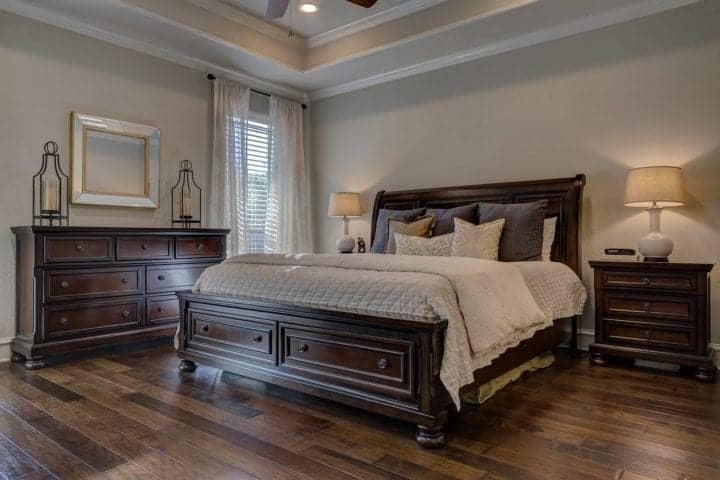
Image from Pixabay
Engineered wood
It’s high-quality plywood with a thin layer of hardwood on top.
- Pros: It looks like a real Hardwood, but it costs a bit less, it’s easier to install on your own, and it doesn’t warp in humid conditions. If installed well, it can last up to 40 years. It’s easy to maintain, and it’s non-allergenic. That’s why it’s excellent in Living rooms and Bedrooms, but unlike Hardwood, it’s also great in Kitchens and Basements.
- Cons: Even though it looks like a real Hardwood, it doesn’t have its durability. Its thin hardwood upper layer means it can be refinished only once or twice (depending on the thickness of the layer). It also doesn’t have Hardwoods’ resale value (it doesn’t affect it). Still wouldn’t recommend it for really moisture-heavy rooms like the Bathroom and Utility room.
Bamboo
Bamboo floors are gaining popularity these days as another alternative to Hardwood.
- Pros: It has a unique look and grows very quickly (because it’s a type of grass, not wood), so it’s a renewable material. Bamboo fibers are so strong that the floor made from it is harder (more durable) than most Harwoods’, which is great for high-foot traffic areas like Living rooms and Dining rooms. It’s DIY-friendly and easy to maintain.
- Cons: Even though it has a unique look, it doesn’t have much of a color variety, and its color fades over time. It easily dings and scratches and water and humidity can damage it. That’s why it’s not recommended for the Bathroom, Basement, Kitchen, and Entryway.
Cork
It’s gaining popularity with time but is still a somewhat unusual choice. It is made from a certain part of an Oak tree bark.
- Pros: It’s warm, soft, and feels spongy under feet, and has an excellent Insulation Value. One of the most eco-friendly materials among these, it’s also anti-allergenic and easy to DIY. All this makes it an excellent choice for Kids’ rooms and Kitchens.
- Cons: It’s less “green” than Hardwood, and its color fades over time (especially if exposed to sunlight). Scratches and dings (leaves an imprint) very easily. Therefore it’s not the best choice for Bathrooms and Utility rooms that are heavy foot-traffic areas and have heavy equipment.
Tile
(starting around £30 per m2)
Porcelain tiles
Made from refined white clay and “baked” at a higher temperature
- Pros: Porcelain tiles have such a vast array of design options, and that makes them very popular. Also tough, and durable, and if they chip, they look better than Ceramic tiles (Porcelain t. has a uniform look inside unlike Ceramic t. which has a ‘design’ only on the surface). They are easy to maintain and moisture-resistant, making them great for Entryways, Kitchens, Bathrooms, Basements, and Garages.
- Cons: If people complain about tiles, it’s usually about them being cold and hard, but there are options for underfloor heating, which of course, makes the installation price go up (so, not that DIY-friendly). They can chip if heavy equipment is put upon them, which means that they are not the right choice for Utility rooms.
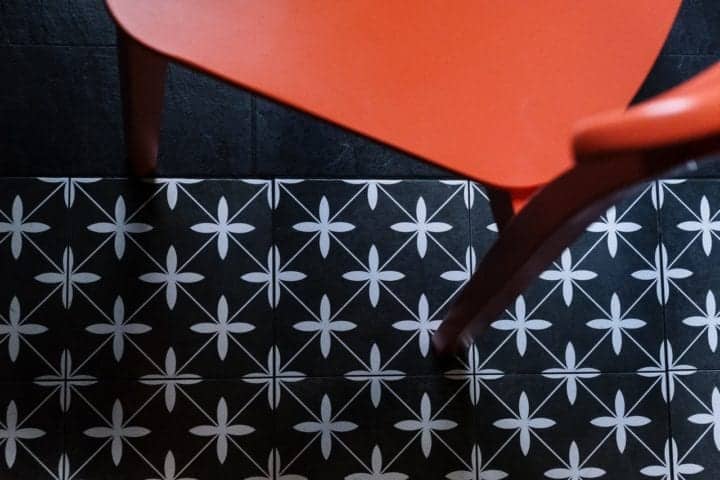 Tiles
Tiles
Ceramic tiles
Made from red, brown, and white clay but “baked” at a lower temperature than porcelain tile
- Pros: Just like Porcelain tiles, Ceramic ones are sturdy, easy to maintain, and eco-friendly, but they cost less than Porcelain ones. A popular choice for Entryways, Bathrooms, and Kitchens.
- Cons: More porous than Porcelain ones, and don’t look uniform when chipped, which means they are harder to fix, therefore not for Utility rooms’ heavy equipment. Also cold and hard without underfloor heating, and not that DIY friendly.
Stone
Stone cost varies for different types of stone. Most popular are: Granite (£80 to £90), Limestone (£50 to £80), Marble (£40 to £70), Porcelain (£50 to £100), Slate (£40 to £50 per m2). You can choose between polished and matte looks, different colors, and shapes of slabs. For example, one of the most popular materials is Travertine, a type of Limestone that has very warm colors, a matte look, porous texture, and high durability. £40 to £400 per m2, depending on the type of material.
Natural stone
£40 to £100 per m2
- Pros: Natural stone has a very attractive, elegant look and great durability, which positively impacts ROI. Anti-allergenic and pet friendly (pet nails can’t leave a mark). The hard-to-scratch surface makes Natural stone a fantastic choice for Entryways, Kitchens, and Garages.
- Cons: It’s a costly option and not a DIY-friendly one. Even though it’s a durable material, there’s still a possibility of chipping and water damage due to porousness, so not for Bathrooms (the porous ones) and Kids’ rooms.
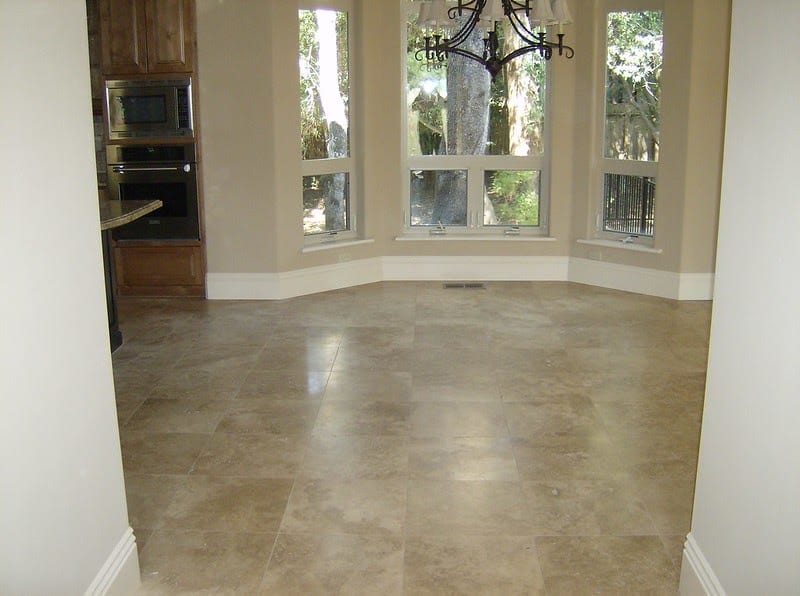
Travertine floor
Concrete
If used inside the home, it gives off a modern (minimalistic) look, but what most people don’t know is that concrete can have a colorful and very stylish look. £60 to £400 per m2.
- Pros: It’s a durable and long-lasting, scratch and dent-resistant material that costs a lot less than Natural stone. So it’s great for Entryways, Bathrooms, Utility rooms, and Garages (if not polished).
- Cons: Surprisingly, it’s not completely moisture resistant. Also, it’s slippery (if polished), cold and hard (so not good for Kitchens and Kids’ rooms, and not so easy to DIY.
Vinyl and Linoleum
Vinyl
You can choose between Vinyl Sheets and Vinyl Tiles (different forms). £200 to £400 per m2 for a medium-sized room. Vinyl Sheets come in a single piece and cover the whole room, which is why it’s not easy for DIY, and you need professional help. It’s less expensive than Vinyl Tiles, but they are more DIY-friendly. There’s also a Luxury Vinyl with a tongue-and-groove plank system. For example, Karndean – Luxury Vinyl made mostly from limestone, can look like real tile or wood, feels warm under feet, and unlike cheaper Vinyl, doesn’t react to changes in the environment. That’s why the price for Karndean Flooring installation is higher than with the first two types of vinyl (Karndean £20 to £50 per m2)
- Pros: Stylish, comfortable, and durable material that’s easy for maintain. It can be used in Entryways, Living rooms, Bedrooms, Kitchens, Bathrooms (sheet vinyl), Utility rooms, and Basements.
- Cons: Once damaged it can’t be repaired, so it doesn’t last as long as some other materials.
Vinyl can emit toxic chemicals (PVC), and it’s not easy to remove it. Also, colors will fade over time if exposed to direct sunlight for longer periods, so not good for any room with intense direct sunlight.

Image from Pixabay
Linoleum
Linoleum is made from natural materials (cork dust, limestone, pine resin, sawdust, etc.) There are three types: Linoleum Sheets, Linoleum Tiles, and Floating Linoleum. DIY – £5 to £20 per m2; Professional – £15 to £30 per m2
- Pros: It has antibacterial properties, and it’s non-toxic, so great for KItchens and Halls. Also, it’s eco-friendly (biodegradable)
- Cons: It scrapes and dents easily, and it’s not moisture resistant, which is not a good choice for Entryways, Bathrooms, and Utility rooms. Its color changes when exposed to sunlight.
Laminate
Laminate is a synthetic multilayered material. Two types are Engineered Wood Laminate and Plastic Laminate. DIY – starting from around £5; Professional – £8 to £12 per m2.
- Pros: Doesn’t scratch or stain easily, which makes it a kids and pets friendly material. It’s durable, easy to maintain, DIY-friendly, and it’s affordable. So it’s recommended for almost all rooms: Entryways, Living rooms, Dining rooms, Bedrooms, and Hallways.
- Cons: Unfortunately, it’s not so moisture-resistant, nor soundproof (noisy footsteps), and not eco-friendly because it contains some potentially harmful chemicals. So it’s not really for Kids’ rooms, Bathrooms, Utility rooms, and Basements.
Carpet
Carpet is, after Hardwood, the most popular flooring material. There are two types of fibers in Carpets: Synthetic fibers (Nylon, Polyester, Polypropylene, Acrylic), and Natural fibers (Wool)
- Pros: The least expensive of all materials, with a plenitude of colors and design choices. It’s soft and quiet (dampens the sounds), and it’s great for Living rooms, Bedrooms, Kids’ rooms, and Halls.
- Cons: It can aggravate allergies (retains allergens and moisture), and it’s harder to clean than any other floor material, so it’s not for Bathrooms, Utility rooms, and Garages. It also lasts the least, with visible wear and tears over time.
Alternatives
- Rubber (£30 to £60 per m2) – Good for Kids’ rooms, Bathrooms, Utility rooms, Garages
- Epoxy resin – Garages and over many other surfaces (for aesthetic reasons or as a surface sealant)
I hope this helped you navigate through all the information on floor materials and installation. It can also help when you start looking for the contractor that best suits you and your needs, or if you decide to DIY it. We hope that this The Most Suitable Flooring Options for Your Home post inspires you. Good luck!


 Tiles
Tiles

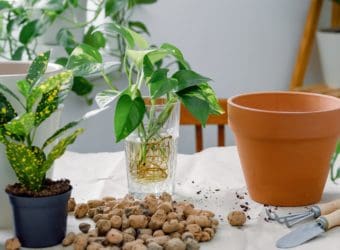
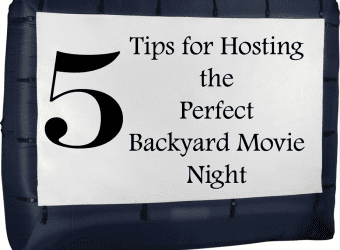
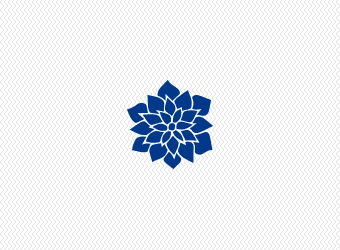
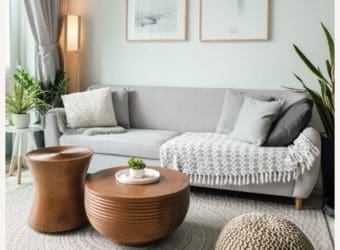

Pingback: 5 Ways to Find the Right Contractor Service Divine Lifestyle
Pingback: DIY Tile Coasters Gift Girls Night in Craft Divine Lifestyle